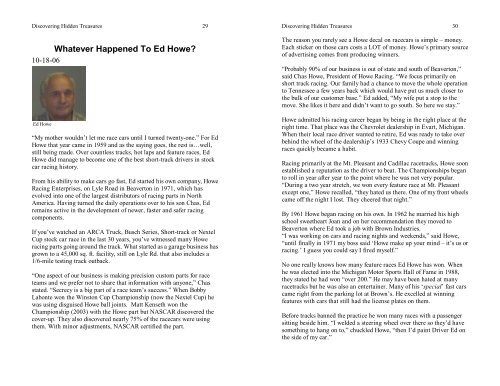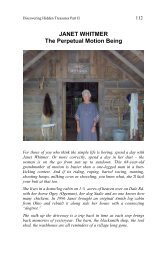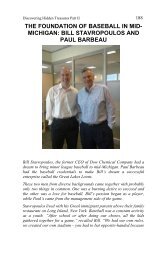Whatever Happened To Ed Howe?
Whatever Happened To Ed Howe?
Whatever Happened To Ed Howe?
- No tags were found...
Create successful ePaper yourself
Turn your PDF publications into a flip-book with our unique Google optimized e-Paper software.
Discovering Hidden Treasures 29<br />
<strong>Whatever</strong> <strong>Happened</strong> <strong>To</strong> <strong>Ed</strong> <strong>Howe</strong>?<br />
10-18-06<br />
<strong>Ed</strong> <strong>Howe</strong><br />
“My mother wouldn’t let me race cars until I turned twenty-one.” For <strong>Ed</strong><br />
<strong>Howe</strong> that year came in 1959 and as the saying goes, the rest is…well,<br />
still being made. Over countless tracks, hot laps and feature races, <strong>Ed</strong><br />
<strong>Howe</strong> did manage to become one of the best short-track drivers in stock<br />
car racing history.<br />
From his ability to make cars go fast, <strong>Ed</strong> started his own company, <strong>Howe</strong><br />
Racing Enterprises, on Lyle Road in Beaverton in 1971, which has<br />
evolved into one of the largest distributors of racing parts in North<br />
America. Having turned the daily operations over to his son Chas, <strong>Ed</strong><br />
remains active in the development of newer, faster and safer racing<br />
components.<br />
If you’ve watched an ARCA Truck, Busch Series, Short-track or Nextel<br />
Cup stock car race in the last 30 years, you’ve witnessed many <strong>Howe</strong><br />
racing parts going around the track. What started as a garage business has<br />
grown to a 45,000 sq. ft. facility, still on Lyle Rd. that also includes a<br />
1/6-mile testing track outback.<br />
“One aspect of our business is making precision custom parts for race<br />
teams and we prefer not to share that information with anyone,” Chas<br />
stated. “Secrecy is a big part of a race team’s success.” When Bobby<br />
Labonte won the Winston Cup Championship (now the Nextel Cup) he<br />
was using disguised <strong>Howe</strong> ball joints. Matt Kenseth won the<br />
Championship (2003) with the <strong>Howe</strong> part but NASCAR discovered the<br />
cover-up. They also discovered nearly 75% of the racecars were using<br />
them. With minor adjustments, NASCAR certified the part.<br />
Discovering Hidden Treasures 30<br />
The reason you rarely see a <strong>Howe</strong> decal on racecars is simple – money.<br />
Each sticker on those cars costs a LOT of money. <strong>Howe</strong>’s primary source<br />
of advertising comes from producing winners.<br />
“Probably 90% of our business is out of state and south of Beaverton,”<br />
said Chas <strong>Howe</strong>, President of <strong>Howe</strong> Racing. “We focus primarily on<br />
short track racing. Our family had a chance to move the whole operation<br />
to Tennessee a few years back which would have put us much closer to<br />
the bulk of our customer base.” <strong>Ed</strong> added, “My wife put a stop to the<br />
move. She likes it here and didn’t want to go south. So here we stay.”<br />
<strong>Howe</strong> admitted his racing career began by being in the right place at the<br />
right time. That place was the Chevrolet dealership in Evart, Michigan.<br />
When their local race driver wanted to retire, <strong>Ed</strong> was ready to take over<br />
behind the wheel of the dealership’s 1933 Chevy Coupe and winning<br />
races quickly became a habit.<br />
Racing primarily at the Mt. Pleasant and Cadillac racetracks, <strong>Howe</strong> soon<br />
established a reputation as the driver to beat. The Championships began<br />
to roll in year after year to the point where he was not very popular.<br />
“During a two year stretch, we won every feature race at Mt. Pleasant<br />
except one,” <strong>Howe</strong> recalled, “they hated us there. One of my front wheels<br />
came off the night I lost. They cheered that night.”<br />
By 1961 <strong>Howe</strong> began racing on his own. In 1962 he married his high<br />
school sweetheart Joan and on her recommendation they moved to<br />
Beaverton where <strong>Ed</strong> took a job with Brown Industries.<br />
“I was working on cars and racing nights and weekends,” said <strong>Howe</strong>,<br />
“until finally in 1971 my boss said ‘<strong>Howe</strong> make up your mind – it’s us or<br />
racing.’ I guess you could say I fired myself.”<br />
No one really knows how many feature races <strong>Ed</strong> <strong>Howe</strong> has won. When<br />
he was elected into the Michigan Motor Sports Hall of Fame in 1988,<br />
they stated he had won “over 200.” He may have been hated at many<br />
racetracks but he was also an entertainer. Many of his ‘special’ fast cars<br />
came right from the parking lot at Brown’s. He excelled at winning<br />
features with cars that still had the license plates on them.<br />
Before tracks banned the practice he won many races with a passenger<br />
sitting beside him. “I welded a steering wheel over there so they’d have<br />
something to hang on to,” chuckled <strong>Howe</strong>, “then I’d paint Driver <strong>Ed</strong> on<br />
the side of my car.”
Discovering Hidden Treasures 31<br />
He attributes his winning formula to running his cars like a business. “I<br />
was always focused and never partied,” <strong>Howe</strong> remembered. “Its easy to<br />
beat drivers that are hungover. Also I raced where I could win money.<br />
Figuring 3 rd place would pay my expenses then 1 st and 2 nd was profit, if<br />
the track, my car and the competition didn’t add up to at least third, I<br />
didn’t go. But there weren’t very many I couldn’t beat.”<br />
“When I raced,” added Chas, “I could find the groove after a few practice<br />
laps. My Dad could look at any track and see the groove.”<br />
One other factor was the superstitious nature of racecar drivers. <strong>Ed</strong> <strong>Howe</strong><br />
feasted on that superstition. Many people remember the ugly green cars<br />
he drove, a very superstitious color in the auto industry. Why green?<br />
First, Brown was discarding a 5-gallon pail of industrial green paint.<br />
<strong>Howe</strong> thinned it with gasoline and brushed it on his car with a broom.<br />
Second, no one wanted to pit near his green cars, which meant no<br />
congestion to deal with on pit stops.<br />
From the headers and exhaust that <strong>Howe</strong> was using at the time came a<br />
high-pitched buzzing sound much like an Indy car would make. The<br />
nickname of the Green Hornet soon followed.<br />
Discovering Hidden Treasures 32<br />
<strong>Howe</strong> climbed out of his racecar for the last time at Auto City Speedway<br />
in Flint in 1991 and says he doesn’t miss it at all. “I finished second to<br />
Chas that night,” recalled <strong>Howe</strong>, “I’d been wanting to get out for a few<br />
years so I thought it was a perfect time to quit. I’ve had my day, quite a<br />
few great days in racing actually.”<br />
So what does the future hold for <strong>Ed</strong> <strong>Howe</strong> and <strong>Howe</strong> Racing Enterprises?<br />
“In the 60’s, I could buy a high performance V-8 for $280,” <strong>Howe</strong> stated,<br />
“I could run that engine all season and sell it for a profit at years end.<br />
Now a Hendricks or Yates engine cost $50,000. We used to have a twoyear<br />
waiting list for <strong>Howe</strong> headers or a chassis. Now you’re lucky if a<br />
customer is willing to wait two weeks. Chas has it tougher than I ever<br />
did. But he’s also a much better diplomat than I was.”<br />
Recently, Stock Car Magazine voted <strong>Ed</strong> <strong>Howe</strong> one of the top 25 most<br />
influential drivers/innovators in the history of stock car racing. “He may<br />
be semi-retired but we still pick his brain,” said Chas. <strong>Howe</strong>’s latest<br />
project is fitting a GTO performance package under a ’57 Chevy body. “I<br />
like taking something old and making it better,” said <strong>Howe</strong>. “I appreciate<br />
a nice riding car.”<br />
<strong>Ed</strong> <strong>Howe</strong> and his Brand X car<br />
Because of his success, many times he<br />
was asked about moving up to ‘the big<br />
time’. “I never saw it that way- when I<br />
raced it was called the Grand National<br />
and honestly the fear would have held<br />
me back,” stated <strong>Howe</strong>. “Not the fear<br />
of driving but rather a fear of knowing<br />
the unsafe conditions at those bigger<br />
tracks especially at the speeds they<br />
were going. <strong>To</strong>day I wouldn’t have that<br />
fear because they’re racing so much<br />
safer now.”<br />
“<strong>To</strong> a racecar driver fear is an inability to lie to yourself,” said Chas. “In<br />
those days, many drivers lied to themselves, thinking everything would<br />
be all right. There is a fine line between fear and intelligence. My father,<br />
a mechanically minded person, could see the potential to die and refused<br />
to lie to himself. Sadly, the death of Dale Earnhardt,” added Chas,<br />
“made it cool to be safe on the track these days. Everyone thought he was<br />
bulletproof.”<br />
<strong>Ed</strong> <strong>Howe</strong> and his ’57 Chevy





